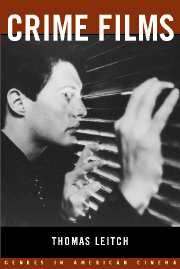Book contents
- Frontmatter
- Contents
- List of Illustrations
- Acknowledgments
- 1 The Problem of the Crime Film
- 2 Historical and Cultural Overview
- 3 Critical Overview
- 4 Fury and the Victim Film
- 5 The Godfather and the Gangster Film
- 6 Double Indemnity and the Film Noir
- 7 Basic Instinct and the Erotic Thriller
- 8 Murder on the Orient Express, Blue Velvet, and the Unofficial-Detective Film
- 9 Chinatown and the Private-Eye Film
- 10 Bullitt and the Police Film
- 11 Reversal of Fortune and the Lawyer Film
- 12 Fargo and the Crime Comedy
- 13 Conclusion: What Good Are Crime Films?
- Notes
- Selected Bibliography
- Filmography/Videography
- Index
5 - The Godfather and the Gangster Film
Published online by Cambridge University Press: 27 October 2009
- Frontmatter
- Contents
- List of Illustrations
- Acknowledgments
- 1 The Problem of the Crime Film
- 2 Historical and Cultural Overview
- 3 Critical Overview
- 4 Fury and the Victim Film
- 5 The Godfather and the Gangster Film
- 6 Double Indemnity and the Film Noir
- 7 Basic Instinct and the Erotic Thriller
- 8 Murder on the Orient Express, Blue Velvet, and the Unofficial-Detective Film
- 9 Chinatown and the Private-Eye Film
- 10 Bullitt and the Police Film
- 11 Reversal of Fortune and the Lawyer Film
- 12 Fargo and the Crime Comedy
- 13 Conclusion: What Good Are Crime Films?
- Notes
- Selected Bibliography
- Filmography/Videography
- Index
Summary
Responding to his fretful, bedridden wife May (Dorothy Tree), who worries, “When I think of all those awful people you come in contact with, downright criminals, I get scared,” double-dealing lawyer Alonzo D. Emmerich (Louis Calhern), who is about to be arrested for his part in a high-stakes jewel robbery in The Asphalt Jungle (1950), blandly reassures her: “Nothing so different about them. After all, crime is only a left-handed form of human endeavor.” His remark neatly encapsulates the defining paradox of the gangster film: Even though professional criminals who come together for the express purpose of committing crimes are rough, unscrupulous, and fearsome, they are at the same time indistinguishable from ordinary citizens like Emmerich, both because Emmerich is so corrupt that he might as well be a gangster, and because gangsters cannot help imitating the society whose norms they set out to violate.
Although it could well be argued that every crime film is a critique of the society crime disrupts, the gangster film is especially concerned with the social order its gang mimics or parodies. This concern begins with the gangster film's obsession with rules. Some rules are so fundamental that they are virtually universal in gangster films. The authority of the leader, if the gang has a leader, is not to be questioned.
- Type
- Chapter
- Information
- Crime Films , pp. 103 - 125Publisher: Cambridge University PressPrint publication year: 2002



